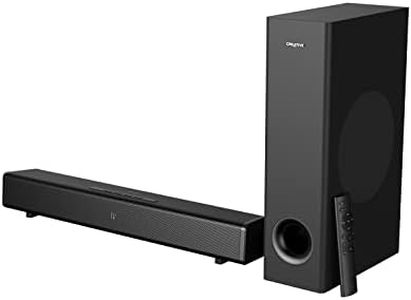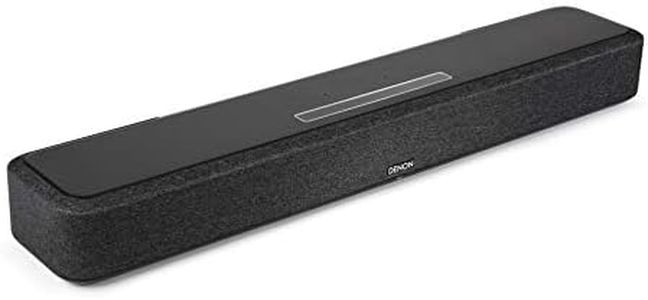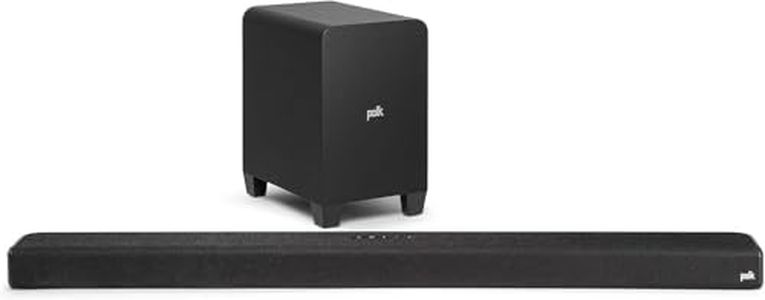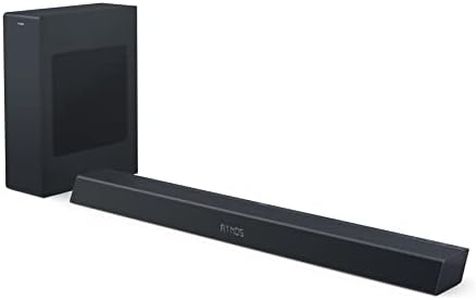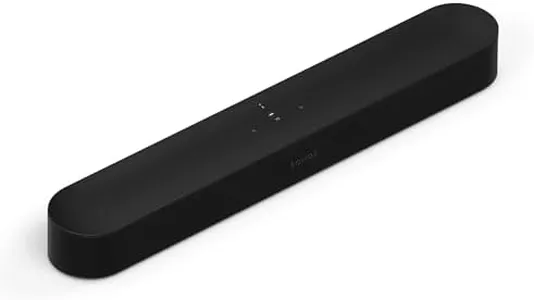We Use CookiesWe use cookies to enhance the security, performance,
functionality and for analytical and promotional activities. By continuing to browse this site you
are agreeing to our privacy policy
10 Best Dolby Atmos Soundbar Under 500
From leading brands and best sellers available on the web.Buying Guide for the Best Dolby Atmos Soundbar Under 500
Looking for a Dolby Atmos soundbar is an exciting step towards bringing immersive audio into your home entertainment system. Dolby Atmos technology adds a sense of height and directionality to audio, making movies, music, and games much more engaging. When choosing a soundbar, it's important to go beyond just the 'Dolby Atmos' label and look at several key specifications to ensure you're getting the right fit for your room, TV, and listening preferences. The goal is to find a well-balanced soundbar that matches your space and viewing habits.Number of ChannelsThe number of channels in a soundbar tells you how many separate audio paths it supports. Common configurations include 2.1, 3.1, 5.1, and more, with the first number indicating the main channels and the second representing the subwoofer. Higher numbers often suggest more speakers and better surround sound simulation. For Dolby Atmos, look for setups marked with a third number (e.g., 5.1.2), where the last digit represents dedicated upward-firing speakers for height effects. If you want true Atmos immersion, prioritize models with up-firing channels; smaller channel counts still work but provide a less dramatic effect. Your room size and where you'll place the soundbar should guide your choice: bigger rooms benefit from more channels, while smaller rooms can do well with simpler setups.
Speaker Configuration (Built-in vs. Separate Speakers)Some soundbars come as a single unit, while others include separate subwoofers or rear speakers. Built-in-only systems save space and look clean, but may offer less impactful bass or surround experience. Systems with a wireless subwoofer deliver deeper, richer bass, and models with rear speakers provide greater surround sound realism. Think about whether you value a simple setup or want extra components for an upgraded audio effect; if you love gaming or action movies, consider options with included subwoofers and, if possible, rear speakers. If simplicity is key for you, a single-structure soundbar can still provide good results, especially in smaller rooms.
Connectivity (HDMI eARC, Optical, Bluetooth, Wi-Fi)Connectivity options determine how easily you can hook up your soundbar to your TV and other devices. HDMI eARC offers the best sound quality and supports advanced features like Dolby Atmos passthrough, so it’s the preferred method if your TV supports it. Optical connections still deliver good sound but may not support the full Atmos experience. Bluetooth and Wi-Fi allow for easy music streaming from phones or computers. Consider how you plan to connect: if you stream a lot or want high-quality Atmos, make sure HDMI eARC is available. For general TV usage, optical or HDMI ARC can still serve well.
Support for Audio FormatsNot all soundbars that say 'Dolby Atmos' handle other advanced audio formats like DTS:X or high-res audio. Wider format support gives you more flexibility and better sound from different streaming services and devices. If you watch content from a variety of sources like streaming apps, Blu-ray players, or game consoles, wider format compatibility is a plus. If most of your content comes from streaming platforms that use Dolby Atmos, you can focus more on Atmos support.
Size and Placement FlexibilitySoundbars range in size from compact to very wide. The width and height can impact how well they fit beneath your TV or within your room layout. A large soundbar may not fit on a small TV stand or could block your TV's remote sensors, while a very small soundbar may not deliver the most powerful sound. Measure your TV stand and the space you intend for the bar, and consider how much room is available for any included subwoofers or satellite speakers. Choose a size that fits your setup and still allows for optimal speaker placement, which helps Atmos effects work better.
Ease of Use and ControlsConsider how easy the soundbar is to operate. Some soundbars offer simple remote controls, app-based controls, or even voice assistant integration. An easy setup process and clearly labeled controls mean less time troubleshooting and more time enjoying your soundbar. If you have family members who aren't tech-savvy, a straightforward interface may be ideal. If you enjoy smart home features or want multi-room music, models with voice assistants or robust apps may be attractive.
Room Calibration FeaturesSome soundbars offer room calibration or audio tuning that uses microphones to adjust the sound for your space. This ensures you get the best sound no matter the size or shape of your room. If your setup is in an unusual or echo-prone room, calibration can make a big difference. For typical living rooms, a soundbar without this feature may still sound great, but calibration is a bonus if you want to optimize your listening experience.
